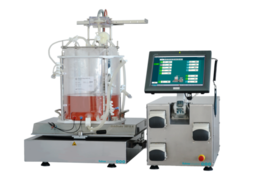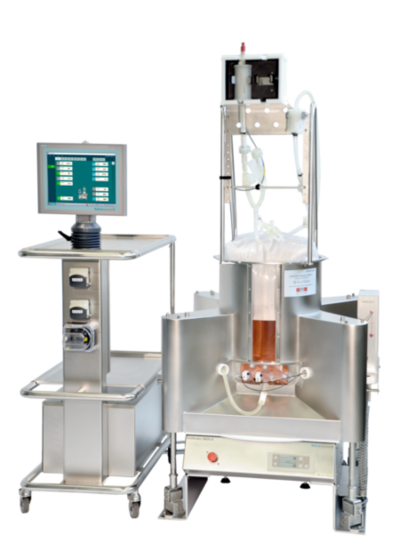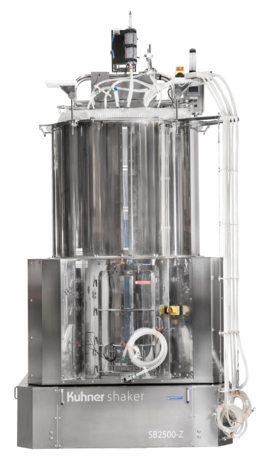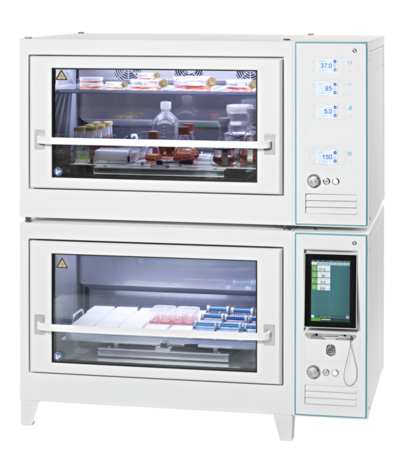to view content for your location.


The orbitally shaken bioreactors (OSB) from Kuhner are ideally suited for the cultivation of mammalian and human cell cultures as well as insect and plant cells. The bioreactors are available in four different sizes with varying working volumes: 1,5-4,5 L and 4-12 L (SB10-X), 15-50 L (SB50-X), 50-200 L (SB200-X), and 500-2500 L (SB2500-Z).
The cylindrical vessels of the bioreactors accept single-use gamma-sterilized 3D bags which require no additional mixing device. Various ports are incorporated for inoculation, aeration, feeding, sampling, and harvesting. Depending on the bag type, online measurement (via built-in chemo-optical sensors), active control of pH and DO, as well as ATF and TFF perfusion processes can also be performed.




Orbitally shaken small scale culture systems are widely used. Microtiter plates (12, 24, 48, and 96 well plates) with working volumes in the µL to mL scale are applied predominantly for high throughput screenings. In the subsequent process development, TubeSpins® (centrifuge tubes) with working volumes between 5 to 35 mL and (disposable) shake flasks are used. Depending on their size, shake flasks have a filling volume of 10 mL up to about 4 L.
Regardless of their size, all of the shaking vessels mentioned above have one feature in common: the orbital mixing of cultivation medium created by the orbital motion of the shaking machine. The consistent hydrodynamics allows for an efficient scale-up from microtiter plates to TubeSpins® to shake flasks, which is from µL to mL to L scale.
For further scale-up, the orbitally shaken bioreactors from Kuhner can expand your process up to a scale of 2500 L. Our systems offer an efficient and smooth process scale-up from microtiter plates to pilot and production scale bioreactors.

The circular vessel geometry and the type of power input create equal hydrodynamics in all orbitally shaken bioreactors. The power input into the liquid is transferred by the vessel wall, which is in contact with the rotating bulk liquid – in contrast to stirred tank bioreactors where the power is transferred solely by the stirrer.
Shaken bioreactors are aerated by bubble-free surface gassing. The shaking motion provides a large gas transfer area due to the slope angle of the bulk liquid and particularly due to the liquid film following the bulk liquid. The large gas transfer area guarantees adequately high kLa values for a good oxygen supply of the cultivated cells.
In stirred tank bioreactors cells may suffer from high shear stress based on the high maximum power input values at the stirrer tips and the bubble aeration of the medium. In contrast, the mechanical shear stress in shaken bioreactors is much lower due to the evenly distributed power input and the bubble-free surface aeration. The gentle orbital shaking motion and bubble-free surface gassing effectively prevent extensive frothing.
Pre-calibrated sensors and gamma-sterilized disposable bags eliminate the need for elaborate calibration, cleaning, and sterilizing procedures when cultivating in Kuhner’s orbitally shaken bioreactors. There is no stirrer required for the shaken bioreactors, zero wearing of moving parts, or sterility problems of the slide ring sealing. This enables a much quicker set up times compared with stainless steel stirred tank reactors of the same size.
All of Kuhner’s orbitally shaken bioreactors are very flexible regarding different cultivation processes due to their large range of working volumes. They can be used in research, process development, and production. The bioreactors are applicable for scale-up processes or can serve as an independent pilot or production reactors. Smaller orbitally shaken bioreactors may provide inoculum for the larger bioreactors, e.g. a culture from the SB10-X can serve as a preculture for the SB50-X and SB200-X OrbShakers.
Characterisation of SB10-X single-use bioreactor
Distribution and mixing times of microcarriers
New Orbital Single Use Bioreactor
Orbital Mixing as an Alternative to Stirred-Tank Bioreactors
Characterization of orbitally shaken single-use bioreactors
Baculovirus-based r-protein production in orbitally SUB
Further Kuhner Technologies: